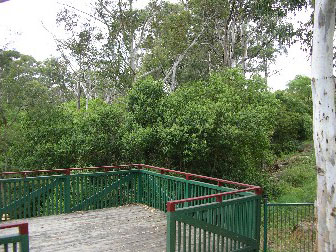 Click To Return To Main Page |
 |
||||||||
 News |
 Eco-Journalists |
 Articles |
 Games |
 Links |
 Facts 'n Fun |
 Email Us |
 About Us |
 Guestbook |
|
|
Action Plan for Save the Trees Day
View from back of park into reserve...and all that horrible privet!
 We formulated an action plan. 1. Get local kids and their parents involved. We set-up Planet Patrol for kids to take responsibility for the future of the planet and we guessed this was a pretty good place to start. 2. We rang Baulkham Hills Shire Council and they sent Helen, a bushcare co-ordinator to come and have a talk to us about our ideas. Helen was great. She never comes to our front door; we just have to watch for where the bushes shake in the reserve - then we know she's there, checking things out. She was enthusiastic about our project, pointed out what was noxious and what was native and gave us some great ideas. She helped us with the paperwork to set-up a formal bushcare group. This way, all volunteers are covered by insurance, we get Council assistance and it will be safer for everyone. 3. We printed out about 160 leaflets and delivered them to everyone in our neighbourhood. We knew we wouldn't get many as everyone is very busy around us and works long hours, plus...and this is the big one, it was fast coming up to Christmas! 4. We got one person reply so we got in touch with our local newspapers and got them to cover our story, we got permission to announce it at school and we talked to our friends. 5. Because the bees could sting people working in the Reserve, we rang an apiarist (beekeeper) and asked if they could move the bees. He told us that the bees were not native bees, but escaped honey bees. It was sad, but they had to be killed. The Queen was buried deep in the tree trunk and the bees would not survive without the Queen. Leaving them was also not possible as honey bees left in the bush spread disease and can destroy the native Australian honeybee - which are tiny, black bees with no sting. Council sprayed them for us. We were upset that our work was causing creatures to be killed, but we knew it was the best if we were going to restore the native habitat. 6. We talked to Helen and organised: tools, poison, grasses, shrubs and trees. Council also put on a BBQ lunch for the bushcare group. 7. Our basic plan is: (a) Destroy privet, working in groups fanning out from top of Reserve. We are going to use the 'cut and paint' method where you cut the privet then quickly paint on some Round-up poison. We will use the chip and paint method for the big privet trees - this is where you bang a chisel into the tree trunk then squirt in some poison. This kills the privet without having to remove the tree so that wildlife can still use the dead tree for refuge. (b) As the smaller privet is cut, it will be piled-up into long piles where it will dry out and can be eventually burnt by the fire brigade. Because many Australian plants need fire to germinate, where the fires have been, there will be an amazing new growth of native plants. (c) Any rubbish found during the 'save the trees' day will be piled-up ready to be removed to the rubbish tip. (d) Once several cleared areas are made, we will get into pairs and plant native bushes, trees and grasses using water crystals. (e) Drains will be cleared and planted with reeds which will slow erosion (wearing away of the soil) and will help clean the phosphates and salt out of the stormwater. (f) We will then keep the newly planted areas clear of privet until the natives have grown above the privet canopy and can fend for themselves. |